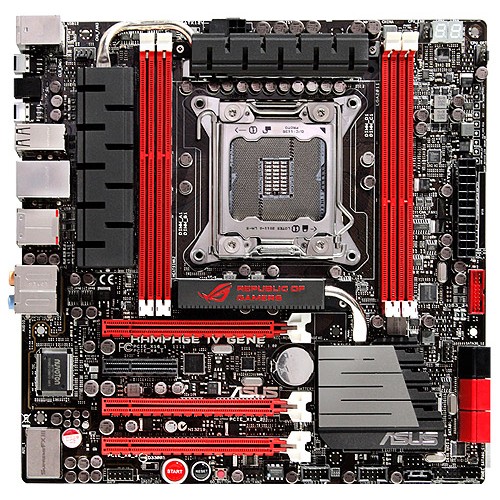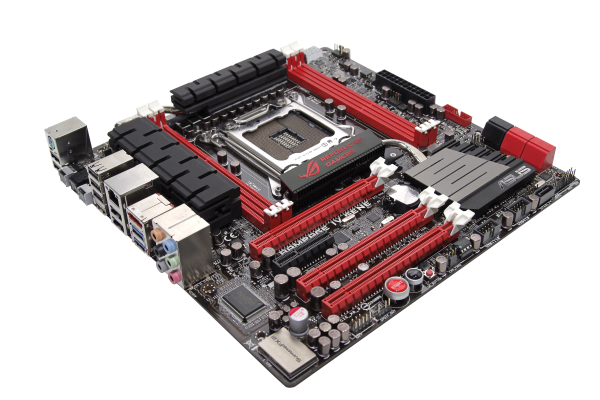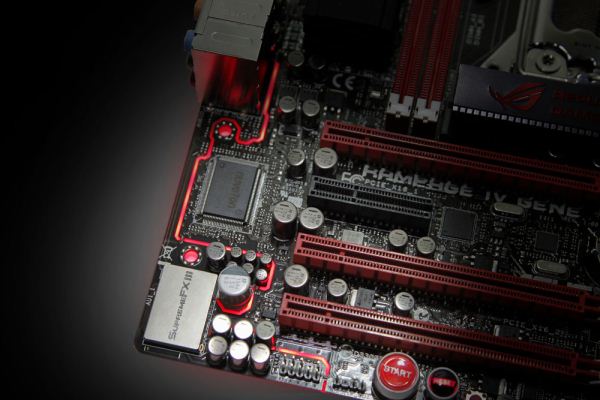ASUS Republic of Gamers and X79 ROG Review – Rampage IV Gene, Formula and Extreme
by Ian Cutress on August 3, 2012 1:00 PM EST- Posted in
- Motherboards
- Asus
- X79
- ROG
Rampage IV Gene Overview
When considering the Rampage IV Gene, it is hard to look past the fact that it is a micro ATX product. Typically for such a price, one would expect a full sized ATX product with all the bells and whistles. But given that we are dealing with the 2011 chipset, almost everything costs a pretty penny anyway, but I also discussed with ASUS their action on the Gene.
Despite the fact that it is a smaller board, it covers several primary markets – power users, small(er) form factor gamers and overclockers. ASUS were keen to stress to me to see the Gene not as a restricted regular ROG board but as the entry level ROG board. From that perspective then it comes to light that yes indeed, the Gene does satisfy a lot of the main criteria for gamers – dual GPU in slots 1 and 3 or 1 and 4 with a full length PCIe card in the middle slot if required. Compared to the Extreme, it also includes an enhanced audio solution.
With the Gene being mATX, we obviously have some restrictions – only four memory slots. But this is given that most gamers will not require more than 16GB of memory (given a typical 4x4 GB setup - the Gene does support 4x8GB). Despite this, we still get more SATA 6 Gbps ports, fully controllable fan headers, enhanced heatsink and heatpipe design for heat transferal and USB 3.0 at the back on top of all the ASUS ROG enabled software (listed later in the review).
Performance wise, all the ROG boards have an advantage over the other X79 boards we have tested in terms of CPU performance at stock, due to ASUS’ policy of applying the maximum turbo mode during any load. This means that with a normal X79 board, the 3960X CPU should run at 3.9 GHz during 1 and 2 threaded load, going down to 3.6 GHz at full load. The ASUS policy is ‘MultiCore Enhancement’, meaning users will get 3.9 GHz whatever the load, giving a 300 MHz improvement at full load.
Thus for the most part, the Gene does perform better than the other X79 boards we have tested. Against the other two ROG boards it does seem to be behind the Extreme and the Formula, but by no means is it a slouch. It performs well under pressure, and is indeed a good entry board for those under the ROG bandwagon. It is also worth mentioning that the Gene comes with a competitive 3-year warranty and qualifies in North America for ASUS Premium Service.
Visual Inspection

The ROG theme is relatively straight forward – red and black, with a little grey and silver if you have to. One thing which may immediately jump out is the size of the heatsinks. Covering the power delivery is a fairly substantial pair of heatsinks connected with a heatpipe. Just to the close proximity of everything in the socket area (note that ASUS always has extra chips to deal with power and overclocking et al. on board), users have the default Intel specifications to deal with on space. Some form of all-in-one liquid cooling system would be ideal here.
For fan headers, users will find one 4-pin to the top left of the socket, two 4-pin headers to the top right of the socket (one to the left of the two-digit debug, one to the right) and another just beside the 24-pin ATX power connector. The final header on board is 4-pin and found on the bottom of the board between the Reset button and the USB header.
Down the right hand side of the board, users will find that two-digit debug previously mentioned (useful for enthusiasts determining errors), the 24-pin ATX power connector, a USB 3.0 front panel header (ASMedia), and the SATA ports. Typically on X79 we have four SATA 3 Gbps and two SATA 6 Gbps from the chipset. Here on the Gene, ASUS are using two SATA 3 Gbps from the chipset (black), two SATA 6 Gbps from chipset (red) and two more SATA 6 Gbps from a controller (red, ASMedia). The other two 3 Gbps ports are found such that one is facing out of the board at the bottom (gray), and one provides the eSATA port on the IO panel.
Along the bottom of the board are our standard array of headers – front panel audio, USB, and also the BIOS chip. The Gene also includes power and reset buttons, useful for reviewers and overclockers. Also onboard is a Go Button, which allows overclockers to apply a set of values selected in the BIOS during system operation. Using such a button could be a help or a hindrance, based on the severity of the overclock and system stability, but it is still a feature ASUS have included.
Special notes should be said about the audio solution. ASUS have dug into their pockets to provide the Gene with a better-than-Realtek solution, in the SupremeFX III. This section of the board has two main features which set it apart from a lot of other standard boards on the market – the audio signaling has its own PCB layer for traces, helping reduce interference. The section is also shielded from interference through the board partitioning, as shown below:
The SupremeFX III solution is rated as having a 110dB SNR, compared to the majority of audio products today offering 108dB SNR or less (typically 92-98dB). As will be mentioned later in the review, this comes about due to the design and a 1500µF capacitor.
The PCIe configuration is designed to help those with more than one PCIe device – GPUs can be placed in any slot and still display video, giving access to other full length PCIe channels or the PCIe x1 slot as required. Ideal routing should allow GPUs in slots 1/3, or 1/4 if an additional card (RAID or PCIe SSD) is required.

Back panel mixes some old and the new – from left to right, we have a combination PS/2 port, two USB 2.0 (black), USB BIOS Flashback button (which I have tested and can confirm it works great), optical SPDIF output, ROG Connect, four USB 2.0 (black, white at bottom for USB Flashback/ROG Connect), Intel GbE, two more USB 2.0 (black), one eSATA 3 Gbps (red), two USB 3.0 (ASMedia, blue), and standard audio jacks.


















34 Comments
View All Comments
jontech - Friday, August 3, 2012 - link
But sounds kind of cool,.Helps that Asus makes it :)
Paulman - Friday, August 3, 2012 - link
Asus Republic of Gamers also holds Starcraft tournaments, as well! That's how I first heard of their brand. In fact, the ASUS ROG Starcraft II Summer 2012 tournament is on right now and I'm watching a game vs. EG.IdrA and EG.Puma (same team, but one American teammate versus a Korean teammate).For more info on this tourney, see: http://rog.asus.com/142982012/gaming/join-the-rog-...
primeval - Friday, August 3, 2012 - link
A fun tournament thus far.For the branding portion of this article, I highly recommend checking out some of ASUS ROG's commercials. They have been playing throughout the aforementioned tournament and I have to say they are probably the best hardware commercials I have ever seen in terms of production quality. I think that if you see a few of those commercials, you may be able to further rationalize the branding award.
Meaker10 - Friday, August 3, 2012 - link
1x/16x/8x/16x would kill any dual card setup in a micro atx case, kinda defeating the point....just4U - Friday, August 3, 2012 - link
the 8x slot is rather pointless...danjw - Friday, August 3, 2012 - link
I would rather see an article on the Ivybridge ROG motherboards then the Sandybridge-E ones. These are very niche boards, though I guess that is only slightly less true of the Ivybridge boards. For heavily threaded and memory intensive applications Sandybridge-E will win. But not really on much else, though they are chosen by some just because they are the most expensive.StevoLincolnite - Friday, August 3, 2012 - link
Also, Sandy Bridge overclocks higher and throws out less heat, because of the silly design choice that Intel made in regards to the heat spreader compound.Not a problem for those who are up to the task of removing the IHS or lapping.
Sad part is that Ivy Bridge actually has nice thermals and power consumption at stock; which could have translated well for enthusiasts.
IvyBridge-E should be out within the next year, haswell will get released and the cycle shall continue.
Hopefully we get 8 core Ivybridge-E chips, which is severely lacking on the Socket 2011 platform with the 3930K's being die harvested 8 core chips, plus most socket 2011 motherboards will take an Ivybridge-e chip anyway, when they're released.
danjw - Friday, August 3, 2012 - link
I was just looking at "leaked" slide that shows Ivy Bridge-E out in Q3 2013 and Haswell out in Q2 2013. I really don't see what the point is of an Ivy Bridge-E if Haswell beats it to the market. With Sandy Bridge-E they released it before the Ivy Bridge tock. I just don't see why that would make much sense.Assimilator87 - Saturday, August 4, 2012 - link
Haswell will probably be limited to four cores, whereas Ivy Bridge-E will scale up to ten cores.mapesdhs - Wednesday, May 9, 2018 - link
I was hunting for R4E refs and found this. It's strange reading what people expected was going to happen back when the R4E was new. IB-E with 10 cores eh? Oh well. Mind you, that did happen with IB-EP, and infact the XEON E5-2680 v2 is one of the best upgrades one can do for an X79 mbd, at least for threaded performance anyway. Hard to avoid wondering how things would have panned out if the 3930K had simply been a fully functional 8-core in the first place, instead of the crippled sampled chip consumers were offered. However, I obtained quite a few, and they still work pretty well, especially with so many PCIe lanes to play with, and it's cool being able to use a 950 Pro to boot from NVMe (comes with its own boot ROM), though the ROG forum does have a thread with custom BIOS profiles available to add native NVMe boot support to various ASUS mbds.